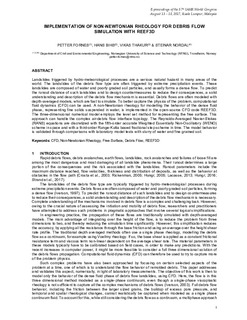Implementation of non-newtonian rheology for debris flow simulation with REEF3D
Abstract
Landslides triggered by hydro-meteorological processes are a serious natural hazard in many areas of the world. The landslides of the debris flow type are often triggered by extreme precipitation events. These landslides are composed of water and poorly graded soil particles, and usually forms a dense flow. To predict the runout distance of such landslides and to design countermeasures to reduce their consequences, a solid understanding and description of the debris flow mechanism is essential. Debris flows are often modeled with depth-averaged models, which are fast to simulate. To better capture the physics of the problem, computational fluid dynamics (CFD) can be used. A non-Newtonian rheology for modelling the behavior of the dense fluid phase, representing fine solids suspended in water, is implemented in the open-source CFD code REEF3D. The three-dimensional numerical model employs the level set method for representing the free surface. This approach can handle the complex air-debris flow interface topology. The Reynolds-Averaged Navier-Stokes (RANS) equations are discretized with the fifth-order accurate Weighted Essentially Non-Oscillatory (WENO) scheme in space and with a third-order Runge-Kutta based fractional step scheme in time. The model behavior is validated through comparisons with laboratory model tests with slurry of water and fine grained soil.
